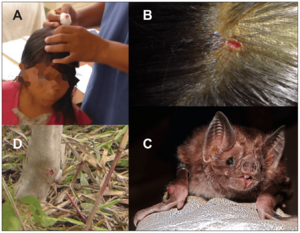Bat-borne virus facts for kids
A bat-borne virus is a type of virus that can be passed from bats to other animals, including humans. Bats act as carriers for these viruses. They can spread them through their saliva (spit) or their feces (poop).
Some well-known examples of viruses that come from bats include coronaviruses (like those that cause SARS and MERS), the Ebola virus, and some types of rabies. Many bats live very close together in large groups for a long time. Scientists believe this habit helps infections spread easily among them. Because bats can fly, they can also carry these viruses over a much larger area compared to animals like rodents.
Contents
What Are Bat-Borne Viruses?
A bat-borne virus is simply a virus that lives inside bats without usually making the bats sick. Bats can carry these viruses and pass them on. When a virus moves from an animal to a human, it's called a zoonotic disease. Many important human diseases started this way.
How Viruses Spread from Bats
Viruses can spread from bats in a few ways:
- Bites: If a bat bites another animal or a person, it can pass the virus through its saliva. This is how rabies often spreads.
- Feces and Urine: Bat droppings (feces) or urine can contain viruses. If these come into contact with food, water, or open wounds, the virus can spread.
- Contact with Bat Fluids: Touching bat blood or other body fluids can also transmit viruses.
- Eating Contaminated Food: Sometimes, fruit or other foods that bats have touched or partially eaten can become contaminated with their saliva or feces. If other animals or humans then eat this food, they can get sick.
Why Bats Are Special Carriers
Bats are unique animals that play a big role in carrying viruses.
- Flying Ability: Bats are the only mammals that can truly fly. This allows them to travel long distances. As they fly, they can spread viruses over a wide area.
- Living in Groups: Many bat species live in huge colonies, sometimes with millions of bats in one cave. Living so close together makes it easy for viruses to pass from one bat to another.
- Strong Immune System: Bats have a very strong immune system. This means they can carry many viruses without getting sick themselves. This also means the viruses can stay in their bodies for a long time.
Examples of Bat-Borne Viruses
Many different types of viruses have been linked to bats. Here are some of the most well-known:
Coronaviruses are a large family of viruses. Some coronaviruses can cause mild illnesses, like the common cold. Others can cause more serious diseases.
- SARS (Severe Acute Respiratory Syndrome): This virus caused a serious outbreak in 2002-2003. It is believed to have originated in bats and then spread to other animals before reaching humans.
- MERS (Middle East Respiratory Syndrome): First identified in 2012, MERS is another serious respiratory illness. It is thought to have come from bats and then spread to camels, which then passed it to humans.
Ebola Virus
The Ebola virus causes a severe and often deadly disease called Ebola virus disease. It causes fever, severe bleeding, and organ damage. Fruit bats are considered the natural hosts (carriers) of the Ebola virus. Outbreaks have occurred mainly in Africa.
Rabies Virus
Rabies is a very serious viral disease that affects the brain and nervous system. It is almost always fatal once symptoms appear. Rabies is usually spread through the bite of an infected animal. Bats are a common carrier of rabies in many parts of the world. If a bat bites a person or another animal, it can transmit the virus.
Nipah Virus
The Nipah virus causes a severe illness that can affect the brain (encephalitis) or cause respiratory problems. It is carried by fruit bats. The virus can spread to humans through contaminated food, especially raw date palm sap that bats have touched, or through direct contact with infected pigs or other animals.
Images for kids
-
The flavivirus West Nile virus
-
The Egyptian fruit bat, a known natural reservoir of Marburg virus and Ravn virus, which cause Marburg virus disease
-
An injury from the bite of a big brown bat
-
The circulation of influenza A viruses. Influenza A viruses in bats possibly originated in birds.
-
Hepadnaviruses have been identified in the tent-making bat, which is native to Central and South America
See also
 In Spanish: Virus portados por murciélagos para niños
In Spanish: Virus portados por murciélagos para niños











